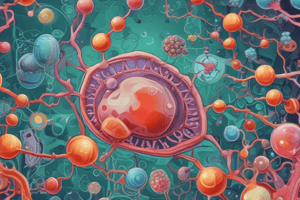Podcast
Questions and Answers
What is the primary structure of a protein?
What is the primary structure of a protein?
- Examples of reversible and irreversible redox states
- Combination of multiple polypeptide chains forming a functional unit
- Sequence of amino acids in a protein (correct)
- 3D overall fold of a protein containing secondary structures
Which bonding patterns and characteristics are associated with alpha-helix and beta sheet?
Which bonding patterns and characteristics are associated with alpha-helix and beta sheet?
- Disulphide bonds and hydrogen bonding
- Covalent bonds and ionic bonding
- Peptide bonds and van der Waals interactions (correct)
- Hydrophobic interactions and electrostatic interactions
What is the role of disulphide bonds in protein structure?
What is the role of disulphide bonds in protein structure?
- Promotion of protein denaturation
- Enhancement of protein degradation
- Induction of protein aggregation
- Stabilization of protein folding (correct)
What is the function of primary sequence in identifying protein localization?
What is the function of primary sequence in identifying protein localization?
Which proteins exhibit quaternary structure?
Which proteins exhibit quaternary structure?
Flashcards
Primary Structure
Primary Structure
The linear sequence of amino acids in a protein chain.
Secondary Structure
Secondary Structure
Hydrogen bonds and van der Waals interactions between amino acid side chains create stable structures like alpha-helices and beta-sheets.
Tertiary Structure
Tertiary Structure
Interactions between distant amino acids, forming a three-dimensional shape.
Quaternary Structure
Quaternary Structure
Signup and view all the flashcards
Disulphide Bonds
Disulphide Bonds
Signup and view all the flashcards
Study Notes
Primary Structure of a Protein
- A protein's primary structure refers to the sequence of amino acids that make up the protein.
Alpha-Helix and Beta Sheet
- Alpha-helix: a spiral shape formed by hydrogen bonding between amino acids, resulting in a stable and rod-like structure.
- Alpha-helix: characterized by a repeating pattern of 3.6 amino acids per turn.
- Beta sheet: a flat, pleated structure formed by hydrogen bonding between amino acids, resulting in a rigid and extended structure.
- Beta sheet: characterized by a repeating pattern of 2 amino acids per turn.
Disulphide Bonds
- Disulphide bonds are strong covalent bonds between two cysteine residues.
- Disulphide bonds play a crucial role in stabilizing protein structure, particularly in proteins that are secreted from cells.
- Disulphide bonds help to maintain protein conformation and prevent protein unfolding.
Primary Sequence and Protein Localization
- The primary sequence of a protein determines its localization within a cell.
- Signals encoded in the primary sequence guide the protein to its target destination, such as the nucleus, mitochondria, or plasma membrane.
Quaternary Structure
- Quaternary structure refers to the arrangement of multiple polypeptide chains in a protein.
- Proteins that exhibit quaternary structure include hemoglobin, antibody molecules, and enzymes.
- Quaternary structure is essential for protein function, as it allows for the formation of active sites and the interaction of multiple subunits.
Studying That Suits You
Use AI to generate personalized quizzes and flashcards to suit your learning preferences.




